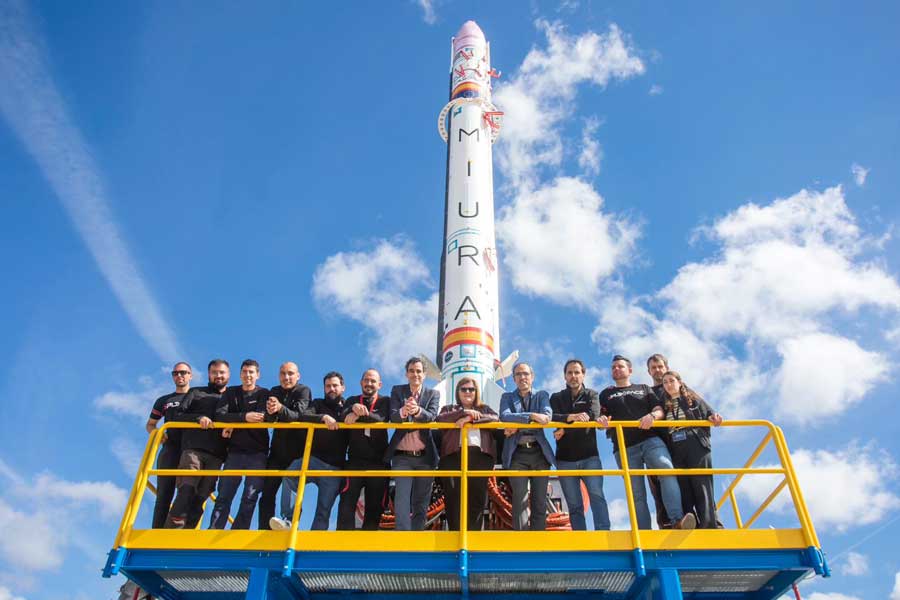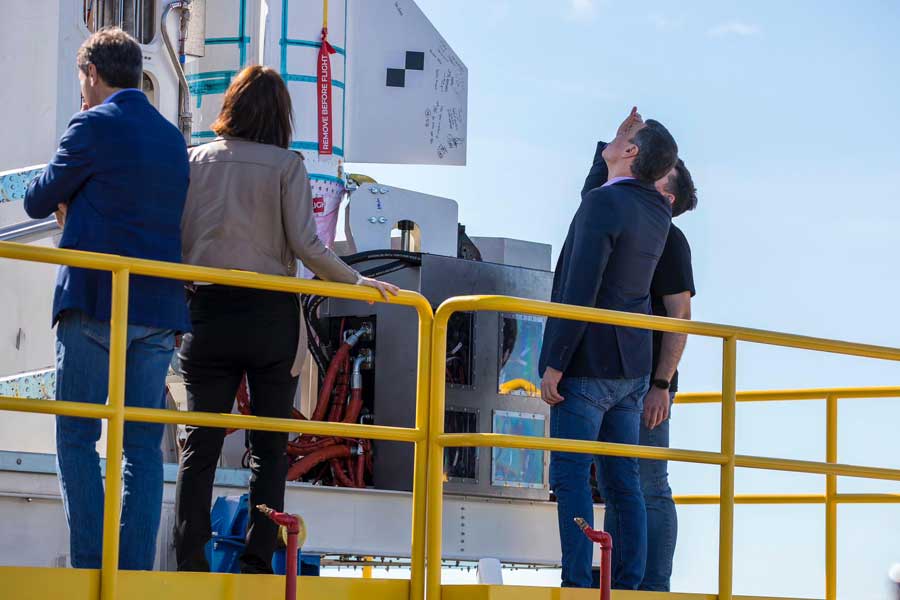PLD Space presents the MIURA 1 flight rocket at its launch base in Huelva ~ with this milestone, the flight demonstration campaign begins.
~
Press Release, Huelva, 11 March 2023: [auto-translated] The Spanish company PLD Space has publicly presented the MIURA 1 rocket at its launch base in Huelva. With this milestone, the suborbital micro-launcher flight demonstration campaign begins, which will take place at the facilities of the El Arenosillo Experimentation Center (CEDEA) of the National Institute of Aerospace Technology (INTA), belonging to the Ministry of Defence of Spain. After completing the preparation work and the relevant tests, the company has different launch windows between April and May.
The ultimate goal is to carry out a first flight test to validate the technology developed so far by PLD Space in real conditions. During the following launches of MIURA 1, the flight requirements will be expanded until valid knowledge and experience are obtained to transfer to the orbital rocket that the company is already developing, MIURA 5, and that will fly from French Guiana at the end of 2024.
During the presentation of the first private rocket in Europe, the founders of PLD Space, Raúl Torres and Raúl Verdú, together with the executive president, Ezequiel Sánchez, have advanced the company’s plans for the coming months in an event that has brought together national authorities like: the President of the Government, Pedro Sánchez; the Minister of Science, Diana Morant; the Secretary General for Innovation, Teresa Riesgo; the commissioner for PERTE Aeroespacial, Miguel Belló; and the director general of INTA, Lieutenant General Julio Ayuso Miguel. The event has also brought together various relevant political, social and institutional representatives from the state and regional levels.
With this milestone, PLD Space takes another step in its mission to improve the lives of people on Earth from space, a thriving market of 1.3 trillion dollars by 2040, according to the non-profit organisation Space Foundation. However, “Europe is at a spatial crossroads”, as the executive president, Ezequiel Sánchez, has pointed out. “The options for access to space by European launchers for 2023 are very limited, between zero and two launches, something totally unusual for Europe and for this sector.”
The problem is that, “although man arrived in space 50 years ago, it is still a changing and complex challenge to maintain.” According to Sánchez, “avoiding a European space winter is a matter of investment”. The transformation of satellite manufacturers has made it necessary to reduce the cost structure of launchers and has revolutionised the way of working in the sector.
The co-founders of PLD Space assumed these difficulties and began working on a project that, 12 years later, is close to providing a new strategic capacity for Spain. To compete in this complex market, the company has opted to provide differential advantages such as “reliability, in fact our MIURA 1 suborbital rocket will serve to demonstrate more than 70% of the MIURA 5 sustainable orbital launcher technology of which, before finalising the decade, we will offer more than 14 annual releases; excellent mission management; and a competitive cost, thanks to the internalisation of the manufacturing of all the subsystems and our recovery and reuse technology”, highlighted the co-founder and head of Business Development, Raúl Verdú.
With the public presentation of MIURA 1 in Huelva, one of the most outstanding milestones for PLD Space begins: the suborbital rocket flight demonstration campaign. The next step will take place in the company’s hangar in El Arenosillo, where the maintenance and launch preparation work will be carried out, which includes everything from pressure tests to propellant loading. When these tasks are finished, they will proceed to the assembly on the ramp and their transfer to the launch base in Médano del Loro.
For MIURA 1, a series of rigorous tests will be carried out to certify that the rocket is ready for flight. One of the most critical will be the Wet Dress Rehearsal (full propellant charge test), which includes all launch steps prior to engine firing. Subsequently, the final test will be carried out: the hot test (static fire test), in which the rocket motor will be turned on for five seconds and will serve to give the green light to the launch. At this time, INTA and PLD Space will formalise the Flight Readiness Review (FRR), which will formalise the preparation of the MIURA 1 launcher for its first launch. Thus, the company will begin all final reviews, final technical checks and simulations for that big milestone.
But before the flight it will be the turn of the integration of the payload in the bonnet of the rocket. The demonstrator micro-launcher will carry an experiment from the German Center for Applied Technology and Microgravity (ZARM), belonging to the University of Bremen, with the aim of verifying in microgravity conditions some of the technologies that this scientific institution has created for the space industry. Then yes, the time will have come and the milestone between INTA, PLD Space and the rest of the teams involved to authorise the flight will be formalised: the formal launch review (Launch Readiness Review, LRR).
~





















